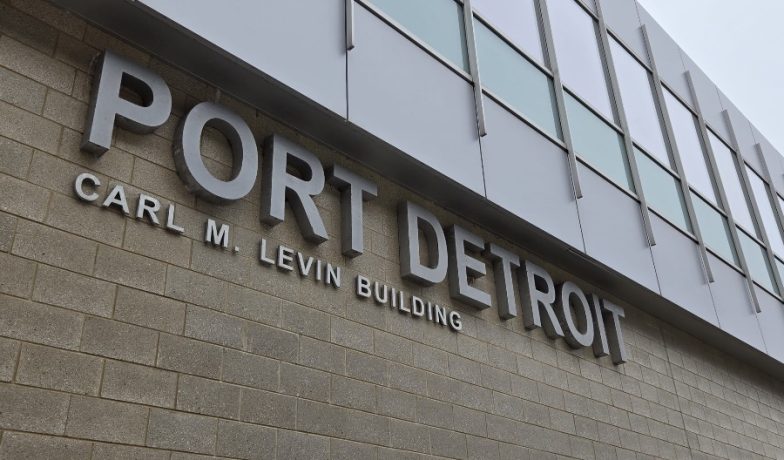Clean Energy Win for Port of Detroit
Then, in October, the port got some game-changing news: the United States Environmental Protection Agency (EPA) announced that Detroit was one of 55 U.S. ports selected to receive almost $3 billion in Clean Ports Program grant money, made available through the federal Inflation Reduction Act. The funding supports work in two broad areas: (1) climate and air quality planning and (2) getting zero-emission vehicles and related equipment into the workplace. The port received $3 million for CAQP efforts and $21.9 million for ZE equipment and charging infrastructure.
Mark Schrupp, the port’s executive director, heralded the EPA’s news, writing in a press release that the funding “will help us achieve our goal of reaching net-zero carbon emissions by 2040 and improving air quality for workers, residents and visitors to this region, who have been fighting for cleaner air for decades.”
The port plans for 50 percent of large vessels to be using biodiesel by 2030 and 100 percent 10 years later, in 2040.
Ambitious Initiatives
To help reach these not-so-distant goals, the port established a number of internal and external initiatives. Terminal operators, for example, have formed a “Low Carbon Port Committee,” which meets quarterly to help with project implementation. In a recent interview, Schrupp said the committee has met twice already and meets again in early December. The new funding, Schrupp noted, will add impetus to the committee’s work. The port may seek formal environmental certification from Green Marine. It is establishing an advisory board – to include community leaders, residents, governmental officials and port businesses – to help with decisions about future projects and standards.
Southwest Detroit Environmental Vision is a neighborhood and community group that has been working with the port. The group will lead upcoming efforts to engage with community members, recruit and educate workers and ensure the environmental justice goals of the grants are fulfilled. Raquel Garcia, Southwest Detroit Environmental Vision’s executive director, said, “We are excited to partner with the Detroit/Wayne County Port Authority and support these projects.”
Schrupp believes it was the port’s extensive engagement and background work with the communities near the port, particularly the partnership with Detroit Environmental Vision, that stood out for EPA reviews as they considered the port’s project applications.
Detroit’s air quality, at least in 2024 and as measured and documented by federal EPA standards, is largely in compliance. One concern with diesel combustion, for example, is exposure to fine particulates from combustion and then ambient dispersion throughout a regional airshed. (This is cited as ‘PM2.5 in regulatory jargon, a reference to particulate matter smaller than 2.5 microns.) The EPA’s primary annual PM2.5 standard is 9 micrograms per cubic meter (µg/m3) of air for an annual mean.
Wayne County data from monitors close to the port show average PM2.5 readings between 7.1 and 8.6 µg/m3. One monitor had a maximum reading of 265.9. At other times, again, in 2024, monitors show PM2.5 levels between 0 and 0.5 µg/m3. These numbers have not been finalized by the EPA. This monitoring protocol is not meant to be used to assess contributions from one source or location from the port. Industrial sources, such as steel plants, are a primary concern regarding PM2.5 emissions in Wayne County, but emissions from those singular facilities are monitored and evaluated via different testing protocols.
Many environmental and community groups argue that the EPA’s air quality standards are too lenient, and they question ambient monitoring data. Some groups contend that there is no safe exposure level for certain pollutants. Indeed, this is a basic tenet for the port’s partners, Southwest Detroit Environmental Vision, which cites a 2017 report, ‘’Disease and Health Inequalities Attributable to Air Pollutant Exposure in Detroit, Michigan,’’ as the basis for claims that people near the port are due environmental considerations beyond minimal standards.
The EPA made it a priority that social benefits – not just environmental benefits – are linked to federal funding commitments. The agency wants federal money to leverage benefits for people living near a port, such as employment opportunities from new investments as well as the availability of workforce training to prepare for new opportunities. Environmental justice was another concern, that grant money would help with air quality so that people who may find it difficult to move, for a variety of reasons, from racial prejudice to poverty, don’t have to put up with degraded environmental conditions that otherwise could be improved.
‘’Our application didn’t start from scratch,” Schrupp said. ‘’We had already engaged with the community. We put a lot of emphasis around engaging with the residents and other organizations that have been working toward cleaner air for years to help us.’’
With alternative energy, Schrupp said that the port’s priority remains a focus on expanding biodiesel fuel. ‘’We want to push the (freight) industry to convert from regular diesel to biodiesel immediately, and at as high a blend as we can get away with,” he added. Schrupp said that supply will be a big factor. He said the port is working to get more biodiesel – at a reasonable price – into southeast Michigan. When it’s available, he said, ‘’We can change the fuel almost immediately.’’ He predicted the switch will be quicker for trucks than ships.
Next Steps
The EPA anticipates making awards when all legal and administrative requirements are satisfied. Schrupp said that, for Detroit, the next important goal is to finalize a grant agreement with the EPA, spelling out all terms and conditions. He noted that the EPA is overseeing distribution of almost $3 billion, a big task that could take a while. ‘’We’re hoping we’ll have final agreements in place by February,’’ Schrupp said, ‘’one for the planning grant and the other for the zero-emissions grant.’’ After that, he said, “We can publish requests for proposals for actual projects and work. This should lay the groundwork for some even bigger and better decarbonization steps.”

Sea Lamprey Control Initiative Enters Five-year Implementation Phase
The Supplemental Sea Lamprey Control Initiative (SUPCON) has entered a new, five-year implementation phase following several years of successful proof-of-concept research. Funded by the Great Lakes Fishery Commission, SUPCON expands... Read More

Alliance for the Great Lakes Addresses the Impact of Data Centers
The Alliance for the Great Lakes (AGL), a nonpartisan, nonprofit organization that works to protect, conserve and restore the Great Lakes, is investigating the impact of data centers and agricultural... Read More



